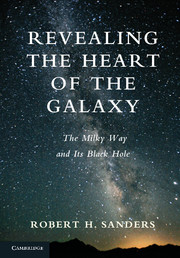Book contents
- Frontmatter
- Contents
- Acknowledgements
- 1 Introduction: The Luminous Pathway
- 2 The Discovery of the Milky Way Galaxy
- 3 The New Physics
- 4 Parting the Veil with Radio Astronomy
- 5 The Violent Universe
- 6 New Windows on the Galactic Center
- 7 The Milky Way as a Barred Spiral Galaxy
- 8 The Evolving View of Active Galactic Nuclei
- 9 The “Paradox of Youth”: Young Stars in the Galactic Center
- 10 Stellar Orbits in the Galactic Center, QED
- 11 Black Holes Here, Black Holes There…
- 12 Traces of Activity: Past, Present, and Future
- 13 After Words: Progress in Astronomy
- References
- Index
8 - The Evolving View of Active Galactic Nuclei
Published online by Cambridge University Press: 05 December 2013
- Frontmatter
- Contents
- Acknowledgements
- 1 Introduction: The Luminous Pathway
- 2 The Discovery of the Milky Way Galaxy
- 3 The New Physics
- 4 Parting the Veil with Radio Astronomy
- 5 The Violent Universe
- 6 New Windows on the Galactic Center
- 7 The Milky Way as a Barred Spiral Galaxy
- 8 The Evolving View of Active Galactic Nuclei
- 9 The “Paradox of Youth”: Young Stars in the Galactic Center
- 10 Stellar Orbits in the Galactic Center, QED
- 11 Black Holes Here, Black Holes There…
- 12 Traces of Activity: Past, Present, and Future
- 13 After Words: Progress in Astronomy
- References
- Index
Summary
The Jet Set
In the late 1970s, confronted by a more plausible explanation for noncircular gas motions observed toward the center of the Galaxy, the idea of impulsive ejections or explosions was falling out of favor. At the same time, the nearest example of an “exploding galaxy,” M82, appeared to be a less dramatic phenomenon – spectacular but not a single energetic event. Reinterpretation of the geometry of the filaments above and below the plane of M82 suggested two expanding bubbles and not motion confined to be parallel to the rotation axis of the galaxy – almost perpendicular to the line of sight. This means the true three-dimensional velocity of the filaments is closer to the observed line-of-sight velocities of 200 to 300 km/s rather than several thousand kilometers per second as originally thought; then the kinetic energy in gas motion is almost 100 times lower than in the original model. In addition, accumulating observational evidence of furious star formation in the plane of the M82 (such as the presence of a number of remnants of massive short-lived stars – supernova remnants) suggested that the outward moving filaments were in fact a large-scale galactic wind fueled by a burst of star formation in the disk of the galaxy – certainly not a massive single explosion.
Even for obviously active galaxies, radio galaxies, the original model of sudden expulsions of enormous clouds of ionized gas and relativistic particles was severely challenged by a new model – a model involving the more steady ejection of relativistic particles from the nucleus to the radio emitting lobes – the jet model.
- Type
- Chapter
- Information
- Revealing the Heart of the GalaxyThe Milky Way and its Black Hole, pp. 99 - 114Publisher: Cambridge University PressPrint publication year: 2013



